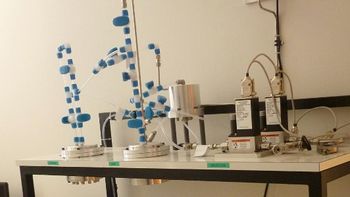Chemical sensors
Chemical sensors
Les OFETs en configuration "bottom contact/bottom gate" peuvent être utilisés en tant que capteurs chimiques lorsque leur canal, constitué du matériau organique, est exposé à un gaz à analyser. Concrètement, un élément à capter (éthanol, acétone, etc.), encore appelé analyte, est envoyé mélangé à un gaz porteur (ici du N2), sur le canal du transistor. Un banc spécialement dédié (Fig. 1) permet de mesurer à la fois la concentration d'analyte dans le mélange et les caractéristiques de sortie du transistor.
Dans un premier temps, les caractéristiques de sortie du transistor organique sont mesurées pour différentes concentrations d'un analyte donné (Fig. 2). La répétition de ces mesures pour différents analytes permet d'établir des tables d'étalonnage.
Dans un deuxième temps, la mesure des caractéristiques de sortie du transistor organique pour un analyte inconnu, à une concentration elle aussi inconnue, et la comparaison de ces caractéristiques avec la table d'étalonnage renseigne sur le type d’analyte (sélectivité) et sur sa concentration (sensibilité).
OFETs in configuration bottom contact/bottom gate can be used as chemical sensors when their channel, made of the organic material, is exposed to a gas that has to be analysed. In practice, an element to be sensed (éthanol, acétone, etc.), else called analyte, est introduced mixed to a carrier gas (here N2), on the channel of the transistor. A specially dedicated bench (Fig. 1) allows to measure at the same time the concentration of analyte in the mixture and the transfer characteristics of the transistor.
At first, the transfer characteristics of the organic transistor are measured for various concentrations of a given analyte (Fig. 2). Repeating these measurements pour different analytes allows to establish calibration tables.
Secondly, measuring the transfer characteristics of the organic transistor for an unknown analyte, at a concentration as well unknown, and comparing these characteristics with the calibration table informs about the type of analyte (selectivity) and about its concentration (sensitivity).
| Fig. 1 : Characterisation bench of chemical sensors based on organic field-effect transistors. | Fig. 2 : Behavior of hole mobility, hysteresis of the transfer characteristics and drain-current (for fixed drain-source Vds and gate-source Vgs voltages), for different ethanol concentrations, during exposure of a transistor with P3HT (PhD thesis of P. Lienerth). |





